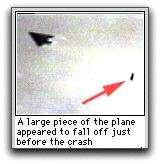-

-
- Home Page || Flight 587 Page || Your Comments @ U.S.Read's Web Log || Send E-Mail to the Editor || Search U.S.Read or the Web ||
-
-
U.S.Read's Flight 587 Preliminary Report
Part 1: NTSB Hypothesis
- Is The Basic Premise Flawed?
July 24, 2004
by
Brett Hoffstadt and Victor Trombettas
From the very first hours after the crash, the NTSB assumption was that the crash of Flight 587 (FL587) was an accident. On November 12th 2001, at a press conference in Washington D.C., Marion Blakey, the NTSB Chairperson at the time, said "all information we have currently is that this is an accident." She said this before her "go team" had even left Washington D.C. to begin their full investigation.
She obviously had no basis for such a statement. And a new post-9/11 context and early witness reports justified a more ominous assumption. In fact, MSNBC, along with other major media, had made the following comment earlier that day:
"The Associated
Press quoted unidentified Bush administration officials
as saying the FBI had concluded that an explosion brought the jet down
and was investigating whether the crash was an accident or sabotage".
Retired firefighter Tom Lynch, an eyewitness, was interviewed on TV and Radio the morning of the crash and was adamant that he saw two explosions while the aircraft was level, before any large pieces started falling from the aircraft. An active duty NYPD officer was fishing in Jamaica Bay and he too saw the aircraft on fire before the tail fell off. Interviewed later that day by NYPD and Federal investigators, this officer was frustrated at how easily his statement was "pooh-poohed", as he put it. Nonetheless, an "accident" is what characterized this tragedy from the start and what has appeared to drive the search for answers.
The NTSB is operating under the hypothesis that the vertical tail failure/separation is the root cause of the "accident". Therefore, according to the NTSB, understanding the pilot's rudder inputs, the forces acting on the tail, and whether the tail structure withstood its ultimate load will explain why FL587 ended in a tragic crash.
In his opening statement at the FL587 Hearings in October 2002, Mr. Robert Benzon, the NTSB's Investigator In Charge of FL587, declared that the tail did not separate until "the aerodynamic and internal loads that the vertical stabilizer experienced were significantly above the ultimate loads required by the French and American certification standards". In other words, the tail worked just like it was expected to.
What caused such excessive loads on the tail? Mr. Benzon addressed this by stating, "the rudder movement(s) resulted in most, if not all, of the loads imposed on the vertical stabilizer".
The final question then would be––who or what moved the rudder so aggressively? The answer from Mr. Benzon is that "Investigators have found no indications of any rudder system anomalies"––which translates to––the pilot was the cause of the rudder movements.
The NTSB established early on, without offering much supporting evidence, that the tail separating the aircraft was the cause of the crash.
As we will be showing in our multi-part report, this hypothesis has serious flaws. It is akin to focusing on why the vertical tail separated from the Space Shuttle Columbia during its breakup over Texas in February 2003. The NTSB has never provided consistent or complete evidence to suggest that the vertical tail separation was the "initiating event". In fact, much evidence exists supporting the alternate hypothesis that the vertical tail separation was merely a consequence of another initiating event.
It's Not An Open and Shut Case
The evidence the NTSB has offered that the tail separation was the initiating event and was the first debris to depart the aircraft is (sections a through d below):
(a) the aircraft
debris recovered farthest from the crash site was the tail.
We have encountered
substantial evidence that challenges this conclusion. It includes
interviews with residents and boat crews who participated in the
recovery of plane debris from the Bay, an examination of the radar
data, the tollbooth video, and the cockpit warning chimes (ECAM).
U.S.Read has interviewed almost every boat crew present in the Bay that
day (NYPD, Coast Guard, U.S. Army Corp of Engineers, Nassau County
Marine Police, and recreational fishermen, including witnesses who
reside on the avenue (Beach Channel Drive) directly facing the Bay.
What we found was that the tail and rudder debris initially hit the
water closer to the Jamaica Bay seawall (closer to the crash site) than
the NTSB reports declare––which suggests the plane became
uncontrollable while the tail was still attached. The NTSB
provided not a single reference for how they determined where the tail
and rudder were "recovered" in the Bay, and they have acknowledged that
the Bay recovery efforts did not include Global Positioning System
notations. The NTSB reports did give Latitude and Longitude
readings––but they completely avoided the topic of how they arrived at
those numbers. None of the recovery crews took such
readings––they
quickly went about recovering items without noting the exact
locations. It appears the NTSB used one reading from the Newark
airport radar data to come up with their location for the tail.
But as we will show––this move on their part was quite a leap, and goes
contrary to what all the JFK radar data truly suggests––the massive
breakup of the aircraft (tail, engines, etc.) did not occur until
later.
Here is some of the evidence that counters the NTSB theory about when tail separation occurred (numbered 1 through 10):
Here is some of the evidence that counters the NTSB theory about when tail separation occurred (numbered 1 through 10):
1. Charlie Vaicels,
who was in a boat in Jamaica Bay along with two other men about a mile
from the final flight path of FL587, witnessed FL587 with a fire on the
left side, then saw the tail separate. He told U.S.Read, "the
tail came off so close to land that I was surprised it landed in the
Bay". The NTSB, on the other hand, alleges the tail separated
while the plane was 3,300 feet north
of the seawall. Mr. Vaicels
does not agree (and he's not alone in that assessment as we will
see). Mr. Vaicels' boat was one of two that assisted the NYPD in
the initial recovery of debris from the Bay––mostly pieces of the tail
or rudder (debris that floated)––before they were asked to leave the
area and the recovery
effort was then continued by the NYPD and the Coast Guard. The
NTSB reports suggest the tail and rudder were found roughly 2,100 and
1,500
feet north of the
seawall, respectively. Mr. Vaicels told U.S.Read his boat
recovered tail debris
approximately 300 feet from the seawall––where most of the debris was
located. (All in all, his boat recovered at least 5 pieces.)
Mr. Vaicels provided U.S.Read with photographs of their recovery effort. In this picture below, his boat is not far from the seawall and the leading edge base of the vertical tail is in his boat.
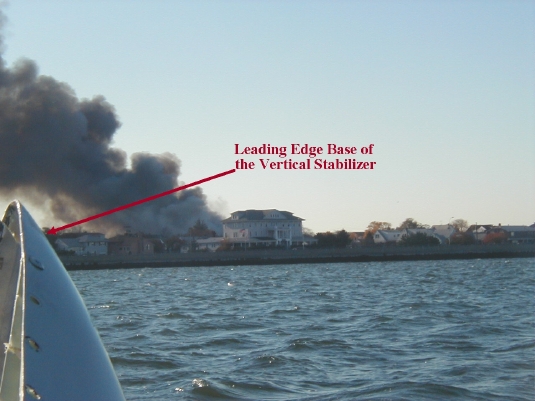
2. Like Charlie Vaicels and his two friends, Terry Auclare and Kenny Brown were also fishing in the Bay except that they were much closer to the final flight path of FL587––so close that they had to move their boat out of the way of the falling airplane debris. Terry, who saw the plane before Kenny, estimates their boat was near 117th street, no more than 300 feet north of the seawall, less than one-half mile from FL587 as it passed by, just in front of them.
They were the closest boat to the flight path and they immediately began recovering debris. They recovered the rudder pieces that had the American Airlines letter "A" painted on both sides. They also recovered a metallic "non-composite" piece that was charred (NTSB has not identified any such parts), and seeing something akin to an aircraft seat falling into the Bay. Terry also recounted to U.S.Read that dozens of dark colored rectangular or square items fell into the Bay (he's not sure what they were) and they did not float (i.e., they descended to the Bay floor). The fact that this debris is not even acknowledged much less identified by the NTSB is very disturbing. We'll report in depth on the debris issues in Part 3 of our report.
Just as Charlie Vaicels and those on board with him reported, Terry and Kenny also reported that FL587 was on fire (or trailing smoke) and shedding debris before the tail broke off. Terry and Kenny added that some of this debris appeared to strike the tail. This is particularly interesting given that the tail and rudder showed some damage that indicated they might have been struck by other parts of the aircraft in flight.
They also recounted to U.S.Read these observations:
Mr. Vaicels provided U.S.Read with photographs of their recovery effort. In this picture below, his boat is not far from the seawall and the leading edge base of the vertical tail is in his boat.

2. Like Charlie Vaicels and his two friends, Terry Auclare and Kenny Brown were also fishing in the Bay except that they were much closer to the final flight path of FL587––so close that they had to move their boat out of the way of the falling airplane debris. Terry, who saw the plane before Kenny, estimates their boat was near 117th street, no more than 300 feet north of the seawall, less than one-half mile from FL587 as it passed by, just in front of them.
They were the closest boat to the flight path and they immediately began recovering debris. They recovered the rudder pieces that had the American Airlines letter "A" painted on both sides. They also recovered a metallic "non-composite" piece that was charred (NTSB has not identified any such parts), and seeing something akin to an aircraft seat falling into the Bay. Terry also recounted to U.S.Read that dozens of dark colored rectangular or square items fell into the Bay (he's not sure what they were) and they did not float (i.e., they descended to the Bay floor). The fact that this debris is not even acknowledged much less identified by the NTSB is very disturbing. We'll report in depth on the debris issues in Part 3 of our report.
Just as Charlie Vaicels and those on board with him reported, Terry and Kenny also reported that FL587 was on fire (or trailing smoke) and shedding debris before the tail broke off. Terry and Kenny added that some of this debris appeared to strike the tail. This is particularly interesting given that the tail and rudder showed some damage that indicated they might have been struck by other parts of the aircraft in flight.
They also recounted to U.S.Read these observations:
• FL587 was
lower in the sky than usual and the tail was still attached (consistent
with U.S.Read's findings that FL587 entered uncontrolled flight, and
began its descent, with the tail still attached).
• They saw flames and smoke, and at one point debris blew back from near the wing section, and appeared to strike the tail. The tail separated after this spray of debris from the midsection flew back, and when it separated––the plane was almost over the peninsula––not 3,300 feet north of it.
• It was only "six seconds from tail separation to impact", said Kenny. This account is similar to many other witnesses, which contrasts the NTSB scenario that the tail broke off almost 17 seconds before impact.
• Terry and Kenny recovered the rudder debris approximately 300 feet from the seawall, when the NTSB reports it was 1,500 feet.
• They saw flames and smoke, and at one point debris blew back from near the wing section, and appeared to strike the tail. The tail separated after this spray of debris from the midsection flew back, and when it separated––the plane was almost over the peninsula––not 3,300 feet north of it.
• It was only "six seconds from tail separation to impact", said Kenny. This account is similar to many other witnesses, which contrasts the NTSB scenario that the tail broke off almost 17 seconds before impact.
• Terry and Kenny recovered the rudder debris approximately 300 feet from the seawall, when the NTSB reports it was 1,500 feet.
Terry and Kenny
along with Charlie Vaicels and his mates, the first boats to recover
debris, aren't even mentioned in the NTSB reports as being part of the
recovery effort. One would think that given their participation
the NTSB would wish to interview them
carefully. But they did
not.
The NTSB's sequence of events simply does not reconcile with these corroborated accounts. In addition, U.S.Read also learned of the following:
3. Three police officers onboard a Nassau County Police Department boat that rushed to the scene stated to us that the rudder debris was much closer to the seawall than 1,500 feet. Based on a topographic map we showed to the officers, they placed the rudder debris less than 600 feet from the seawall––exactly the area given to us by the recreational boaters––very close to the seawall. Additionally, the first of three officers on this boat to witness the flight told U.S.Read the aircraft was clearly on fire for several seconds before the tail broke off.
4. Further evidence that the tail separation occurred later in the crash sequence and was not the initiating event is the following photo (Courtesy of the Albuquerque Journal) and taken at 117th street––right by the seawall.
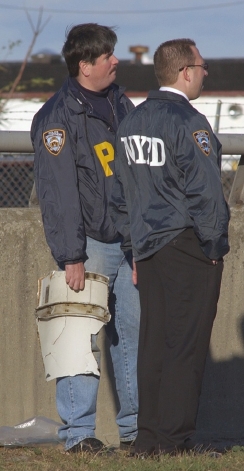
The object held by the NYPD officer, which was recovered on land, is a section of the rudder that covers hinge 7 (near the top of the rudder). It was not the only piece of rudder that was found in that area––nor was it the only aircraft debris. This evidence also suggests that the separation and disintegration of the rudder and tail must have occurred later in the crash sequence and closer to the crash site in order for some of the rudder debris to miss the Bay and fall on land.
It could be argued by the NTSB that what they meant by "recovery" location in their reports was: "where the tail and rudder fell into the Bay"; not necessarily where the debris was later found. They could add that the debris drifted on the water in a southerly direction towards the seawall where it was seen and recovered by the boaters we have referenced. But this position can be refuted (in item 5 below), and it doesn't address why some pieces made it onto land, especially when the winds were not blowing in a southerly direction (they were blowing from the west/northwest according to readings at JFK at the time of the crash).
5. Mr. Harold Keller, who lives on Beach 124th street just down the block from the Bay seawall (Beach Channel Drive), saw the vertical stabilizer very soon after the crash "about 450 feet, at most, from the seawall." U.S.Read learned from the Army Corp of Engineers that at that time in the morning on that day, the Bay was draining. The tail, therefore, would have drifted out. That is exactly what Mr. Keller tells us happened to the tail. Within a half hour, it had drifted further out with the tide to where it, at times, got stuck in a shallow part of the Bay. Mr. Keller yelled out to the NYPD officers on the Harbor Unit boat (which was close to the seawall) that the tail had drifted further out. An NYPD officer on the boat replied to him that they were aware of it, did not have the equipment needed to recover the 27-foot tail, but were able to attach a red buoy ball to the tail to mark it. The NYPD Harbor Unit then kept watch over the tail until the early afternoon (approximately 5 hours after the crash) when the Army Corp of Engineers recovered it.
This picture below (provided by the U.S. Army Corp of Engineers) shows the tail with the red ball attached, as Mr. Keller described.
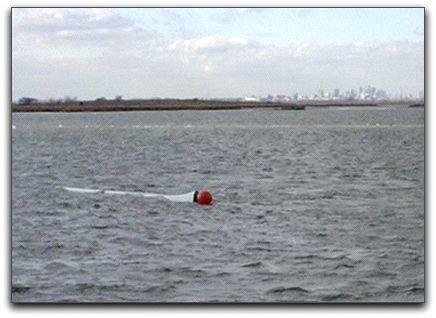
6. Joanne Rietschel, lives on Beach 129th Street, also just in from the seawall. Mrs. Rietschel was in her home that morning at 9:16 A.M. when she heard a "boom". Not knowing what had happened she looked out her window overlooking the Bay and immediately knew it had been a plane crash because she saw the American Airlines tail with the large A (on both sides) twisting its way down to the Bay. She made the following statement to U.S.Read:
The NTSB's sequence of events simply does not reconcile with these corroborated accounts. In addition, U.S.Read also learned of the following:
3. Three police officers onboard a Nassau County Police Department boat that rushed to the scene stated to us that the rudder debris was much closer to the seawall than 1,500 feet. Based on a topographic map we showed to the officers, they placed the rudder debris less than 600 feet from the seawall––exactly the area given to us by the recreational boaters––very close to the seawall. Additionally, the first of three officers on this boat to witness the flight told U.S.Read the aircraft was clearly on fire for several seconds before the tail broke off.
4. Further evidence that the tail separation occurred later in the crash sequence and was not the initiating event is the following photo (Courtesy of the Albuquerque Journal) and taken at 117th street––right by the seawall.

The object held by the NYPD officer, which was recovered on land, is a section of the rudder that covers hinge 7 (near the top of the rudder). It was not the only piece of rudder that was found in that area––nor was it the only aircraft debris. This evidence also suggests that the separation and disintegration of the rudder and tail must have occurred later in the crash sequence and closer to the crash site in order for some of the rudder debris to miss the Bay and fall on land.
It could be argued by the NTSB that what they meant by "recovery" location in their reports was: "where the tail and rudder fell into the Bay"; not necessarily where the debris was later found. They could add that the debris drifted on the water in a southerly direction towards the seawall where it was seen and recovered by the boaters we have referenced. But this position can be refuted (in item 5 below), and it doesn't address why some pieces made it onto land, especially when the winds were not blowing in a southerly direction (they were blowing from the west/northwest according to readings at JFK at the time of the crash).
5. Mr. Harold Keller, who lives on Beach 124th street just down the block from the Bay seawall (Beach Channel Drive), saw the vertical stabilizer very soon after the crash "about 450 feet, at most, from the seawall." U.S.Read learned from the Army Corp of Engineers that at that time in the morning on that day, the Bay was draining. The tail, therefore, would have drifted out. That is exactly what Mr. Keller tells us happened to the tail. Within a half hour, it had drifted further out with the tide to where it, at times, got stuck in a shallow part of the Bay. Mr. Keller yelled out to the NYPD officers on the Harbor Unit boat (which was close to the seawall) that the tail had drifted further out. An NYPD officer on the boat replied to him that they were aware of it, did not have the equipment needed to recover the 27-foot tail, but were able to attach a red buoy ball to the tail to mark it. The NYPD Harbor Unit then kept watch over the tail until the early afternoon (approximately 5 hours after the crash) when the Army Corp of Engineers recovered it.
This picture below (provided by the U.S. Army Corp of Engineers) shows the tail with the red ball attached, as Mr. Keller described.

6. Joanne Rietschel, lives on Beach 129th Street, also just in from the seawall. Mrs. Rietschel was in her home that morning at 9:16 A.M. when she heard a "boom". Not knowing what had happened she looked out her window overlooking the Bay and immediately knew it had been a plane crash because she saw the American Airlines tail with the large A (on both sides) twisting its way down to the Bay. She made the following statement to U.S.Read:
"It looked so close
to the house that my first instinct was that I could reach out and
touch it. The color of the tail and the letter A on both sides
were so apparent and clear. It was very clear, very large, very
close to the seawall––so close that if I wasn't wearing my glasses I
think I would have still been able to make out the A's on the
tail. The tail fell between the seawall and the green buoy."
The green buoy Mrs.
Rietschel refers to is approximately 1700 feet from the seawall.
Based on her statement, the tail hit the Bay no more than 850 feet from
the seawall.
Would Mrs. Rietschel describe the tail as she did if it had separated 3,300 feet from the seawall as the NTSB theory alleges?
7. Eyewitness Tom Lynch spoke with one of the two NYPD Officers who were in the Bay at the time of the crash and retrieved debris along with the recreational boaters (these officers are pictured on the first page of our summary). Mr. Lynch passed on to us:
Would Mrs. Rietschel describe the tail as she did if it had separated 3,300 feet from the seawall as the NTSB theory alleges?
7. Eyewitness Tom Lynch spoke with one of the two NYPD Officers who were in the Bay at the time of the crash and retrieved debris along with the recreational boaters (these officers are pictured on the first page of our summary). Mr. Lynch passed on to us:
"There is a red buoy
(R2) just off the seawall. The officer told me "the tail, fell
within a 500 foot radius of this red
buoy".
This red buoy is
approximately 700 feet from the seawall. This
statement, from the first NYPD officers on the scene, is consistent
with the other statements we have highlighted above. If the
debris had been much further out––then the officer would have instead
used the
green buoy as his point of reference (which is 1,700 feet out––see
picture below).
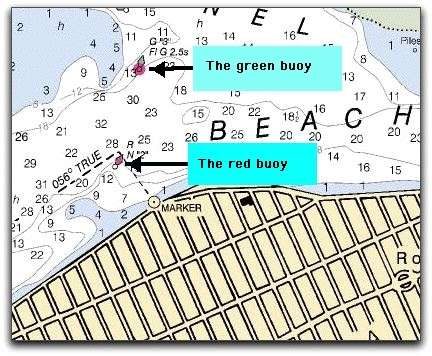
8. The radar data does not support the NTSB theory about when and where the tail separated. There is no airborne debris near where the tail is alleged to have separated (at .83NM north of the crash site), and only 1 piece of debris shows up in the entire red zone in the graphic below. However, more airborne debris appears on the JFK radar much closer to the impact site, in the green zone, very close to the Bay seawall, in the same area where many witnesses are telling us the tail separated.
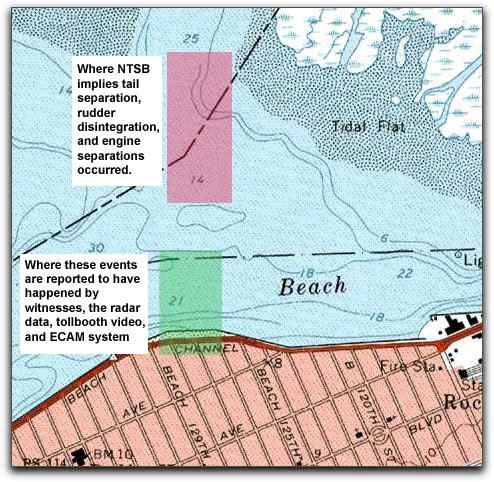
9. The tollbooth video does not indicate that major catastrophes like tail separation and engine separations occurred at the time the NTSB claims they did. It indicates the opposite, that catastrophic failures occurred in the green zone (see above picture). We'll cover this in more detail in Part 4 of our report.
10. The cockpit warning system (ECAM) is noticeably silent during the time of alleged tail separation––there are no level 3 warnings (repetitive chimes) when, according to the NTSB's timeline, there should be. Consistent with the eyewitness statements, radar data, and tollbooth video, the audible cockpit warnings (recorded by the Cockpit Voice Recorder - CVR) indicate that major structural failures did not occur until the flash and large smoke trail are seen on the tollbooth video (approximately 9 seconds after the NTSB's assumed time of tail separation). Again––in the green zone.
The NTSB might yield and agree that the debris was recovered closer to the seawall then they have previously reported, but they might maintain that the tail (and rudder debris) flew forward (in the same direction as the aircraft) after it separated to account for why it landed in the green zone.
Besides contradicting every eyewitness who saw the tail separate, this feat is aerodynamically improbable, if not impossible, especially for the distances we are considering (up to 3,000 feet).
Consider this footage at cnn.com, from an airshow in September 1997, which shows a piece of wing separating from a Stealth fighter before it crashes. The wing quickly bleeds off any forward momentum and, within perhaps a few hundred feet of forward flight, is falling straight down (click the link to view the video):

8. The radar data does not support the NTSB theory about when and where the tail separated. There is no airborne debris near where the tail is alleged to have separated (at .83NM north of the crash site), and only 1 piece of debris shows up in the entire red zone in the graphic below. However, more airborne debris appears on the JFK radar much closer to the impact site, in the green zone, very close to the Bay seawall, in the same area where many witnesses are telling us the tail separated.

9. The tollbooth video does not indicate that major catastrophes like tail separation and engine separations occurred at the time the NTSB claims they did. It indicates the opposite, that catastrophic failures occurred in the green zone (see above picture). We'll cover this in more detail in Part 4 of our report.
10. The cockpit warning system (ECAM) is noticeably silent during the time of alleged tail separation––there are no level 3 warnings (repetitive chimes) when, according to the NTSB's timeline, there should be. Consistent with the eyewitness statements, radar data, and tollbooth video, the audible cockpit warnings (recorded by the Cockpit Voice Recorder - CVR) indicate that major structural failures did not occur until the flash and large smoke trail are seen on the tollbooth video (approximately 9 seconds after the NTSB's assumed time of tail separation). Again––in the green zone.
The NTSB might yield and agree that the debris was recovered closer to the seawall then they have previously reported, but they might maintain that the tail (and rudder debris) flew forward (in the same direction as the aircraft) after it separated to account for why it landed in the green zone.
Besides contradicting every eyewitness who saw the tail separate, this feat is aerodynamically improbable, if not impossible, especially for the distances we are considering (up to 3,000 feet).
Consider this footage at cnn.com, from an airshow in September 1997, which shows a piece of wing separating from a Stealth fighter before it crashes. The wing quickly bleeds off any forward momentum and, within perhaps a few hundred feet of forward flight, is falling straight down (click the link to view the video):
None of the experts
we've consulted with believe FL587's tail would have traveled forward
very far after it had separated. If the NTSB chose this argument,
it would not be met with much expert endorsement.
Based on public
statements the NTSB has made, a second piece of evidence they believe
supports their conclusion about when the tail separated is:(b) The rudder
position data in the Digital Flight Data Recorder (DFDR)
went to zero approximately 16 seconds before impact (at the time the
"Loud Bang"
is heard on the CVR) and the pilot lost control quickly
thereafter.
The NTSB interpreted
this as the moment the tail separated without ever
publicly mentioning, or explaining, other failures the DFDR showed
concurrent with the rudder
data going to zero; spoilers 2, 3, 5 had failed (spoilers 3 and 5
provide additional turn or
"roll" control similar to the ailerons). It's
possible that the rudder data "going to zero" could indicate
something other than tail
separation had occurred. For example,
it could indicate a total loss of hydraulic pressure at the rear of the
aircraft, or loss of signal from the rudder position sensor, due to
some damage the aircraft had suffered somewhere forward of the tail
section.
If the NTSB automatically assumes that zero rudder data in the DFDR is proof that the entire tail had separated, shouldn't they also assume that zero spoiler data (or faulted spoilers) means the spoilers separated at nearly the same time? If that is true, the NTSB now must explain multiple concurrent structural failures—something more consistent with an explosion or fire, not an aggressive pilot.
If the NTSB automatically assumes that zero rudder data in the DFDR is proof that the entire tail had separated, shouldn't they also assume that zero spoiler data (or faulted spoilers) means the spoilers separated at nearly the same time? If that is true, the NTSB now must explain multiple concurrent structural failures—something more consistent with an explosion or fire, not an aggressive pilot.
Flight 587 Investigators have told U.S.Read they believe the following also supports the official theory:
(c)
The lateral loads (the side forces) on FL587 got
as high as 0.8g after the NTSB's assumed moment of tail
separation. Investigators believe such high lateral forces could
only be achieved if the tail was gone.
However, American
Airlines Flight 903 in 1997 experienced
similar side loads in flight (0.7g lateral loads and much higher vertical loads than
FL587) and yet the tail was attached. The presence of high loads
on FL587 is not conclusive proof that the tail had
departed.
One final piece of evidence that supports the NTSB theory is:
(d) The crew lost
control of the aircraft after the DFDR lost rudder
data.
We are in agreement
with the NTSB that the pilot of FL587 lost control
of the aircraft at this time and that the rudder was unusable. But the
NTSB may have erred in making too quick a leap in concluding this was
the time the tail separated. The DFDR evidence also shows that
the pilot lost some roll control at the same moment as the Loud Bang
(spoilers 2, 3, and 5 faulted). And just moments later
the aircraft was experiencing greater engine thrust on the right side
by at least 7%. This thrust differential was probably increasing
as the DFDR data abruptly ended.
If we consider the cumulative effects of the following events, then we have a very credible alternative scenario for how and why the pilot could lose control while the tail was still attached:
If we consider the cumulative effects of the following events, then we have a very credible alternative scenario for how and why the pilot could lose control while the tail was still attached:
1. the loss of
rudder control (not due to tail separation but to
loss of hydro-mechanical control)
2. the loss of some roll control authority (the spoilers)
3. a 7% larger thrust force on the right side
4. an increasing sideslip to the left (the nose of the aircraft was to the left of the flight path), and . . .
5. perhaps most importantly, the instability and loss of control introduced by the initiating event (explosion or fire).
2. the loss of some roll control authority (the spoilers)
3. a 7% larger thrust force on the right side
4. an increasing sideslip to the left (the nose of the aircraft was to the left of the flight path), and . . .
5. perhaps most importantly, the instability and loss of control introduced by the initiating event (explosion or fire).
What started the tragic chain of events? What were the pilots reacting to? What were the earliest pieces of debris? These are the most critical questions that must be answered if FL587 is to be understood.
In our next release (Parts 2 and 3), we compare the handling of the debris fields in the FL587 and Shuttle Columbia Investigations.
You can comment on this article at U.S.Read's new Web Log at: http://usread.blogspot.com/
Home Page || Flight 587
Page || Your Comments @
U.S.Read's Web Log || Send E-Mail to
the Editor || Search
U.S.Read or the Web ||
